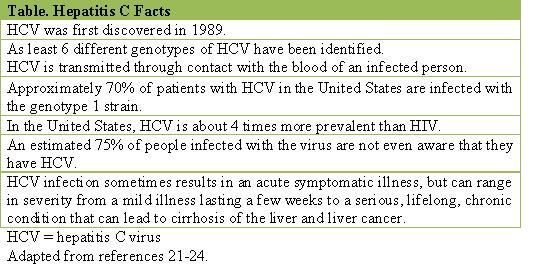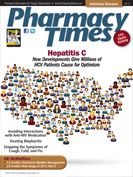Publication
Article
Pharmacy Times
Hepatitis C: New Developments Give Millions Cause for Optimism
Author(s):
With an all-oral combination therapy and a hepatitis C vaccine on the horizon, pharmacists and patients will soon have new resources against this prevalent infection.
With an all-oral combination therapy and a hepatitis C vaccine on the horizon, pharmacists and patients will soon have new resources against this prevalent infection.
According to the Centers for Disease Control and Prevention (CDC), infection with hepatitis C virus (HCV) is the most prevalent and chronic bloodborne infection in the United States. 1 Approximately 3.2 million individuals in the United States and 170 million individuals worldwide have HCV, and an additional 3 million individuals are infected each year. 1-3
HCV is considered the leading cause of liver cirrhosis, transplantation, and hepatocellular carcinoma. 1,3 Statistics from the CDC report that HCV is most prevalent among those individuals born between 1945 and 1965, with the majority of those likely infected during the 1970s and 1980s, when infection rates were highest. 4,5
Of the population infected with HCV, approximately 75% to 85% eventually develop chronic HCV. 1,4 Chronic HCV accounts for an estimated 8000 to 10,000 deaths annually. 4,5 Unfortunately, some researchers believe that the mortality rate attributed to HCV could possibly triple by 2030 if current recommendations and strategies for both the diagnosis and management of HCV remain the same. 4,5 Furthermore, findings from a CDC study presented at the 2011 American Association for the Study of Liver Diseases 62nd Annual Meeting reported that beginning in 2006, more deaths were related to HCV infection than to HIV infection. 6
Vaccine on the Horizon
Although there is no vaccine currently available for protecting against HCV, one is being researched and developed. A potential vaccine against HCV has shown promising results in a small, early-stage clinical trial. 7 The vaccine is formulated to generate a response by T cells against the virus’ internal proteins, rather than creating an antibody attack on the everchanging outer coat of the HCV virus. 7-9
Results of the Phase 1 trial, which included 41 healthy volunteers, were published in the January 4, 2012, issue of Science Translational Medicine. 7-9
The findings stated that subjects produced favorable immune responses with no major adverse effects for the 1-year study period. 7-9 The development of a vaccine for HCV is still in the preliminary stages, and a Phase 2 trial will provide more insight into the vaccine’s effectiveness. 7-9
The Oxford University researchers who conducted this first trial in humans are initiating additional trials to determine if the vaccine is effective in patients with active HCV infection. 7-9 The continuing study will most likely take 2 to 3 years. A separate research team in the United States is also planning a larger trial in at-risk groups to see if the vaccine can protect against HCV. 7-9
Results from another recent study reported that screening all individuals born between 1945 and 1965 for HCV could identify more than 800,000 undiagnosed cases, save tens of thousands of lives, and prove to be a cost-effective measure. 5,10 Currently, the CDC recommends screening for HCV in those individuals who are at risk due to certain high-risk activities or behaviors. 4,5 Factors that increase HCV risk include having a history of injectable drug use, having abnormal liver tests or liver disease, being a chronic hemodialysis patient, receiving a blood transfusion before 1992, or being a health care worker who has regular contact with blood at work. 4,5
Current Pharmacologic Treatments
The standard treatment for HCV is peginterferon alfa and ribavirin. 3,11 This combination therapy can be expensive, prolonged, and accompanied by significant adverse effects. 3 The most common adverse effects associated with standard therapy include myalgias, headaches, and other flu-like symptoms, as well as dermatologic, gastrointestinal, neuropsychiatric, and hematologic effects. 3,12 These adverse effects can often lead to a lack of patient compliance or a discontinuation of drug therapy. 3,12
In May 2011, the FDA approved 2 new oral drugs for the treatment of HCV. The first of this new generation of pharmacologic agents, referred to as protease inhibitors, was boceprevir, which is marketed as Victrelis (Merck). Boceprevir is the first drug approved in the United States for HCV in almost a decade. 13,14 It is classified as an HCV NS3/4A protease inhibitor and is indicated for the treatment of chronic HCV genotype 1 infection, in combination with peginterferon alfa and ribavirin, in individuals 18 years or older with compensated liver disease, including cirrhosis, who are previously untreated or who have failed previous interferon and ribavirin therapy. 13,14
Boceprevir should not be prescribed as monotherapy, and must be used in conjunction with peginterferon alfa and ribavirin; therefore, all contraindications and warnings for peginterferon alfa and ribavirin should also be considered. 13,14 Boceprevir is administered orally, typically in doses of 800 mg 3 times daily with food. The most commonly reported adverse effects include fatigue, anemia, headache, nausea, and dysgeusia. 13,14
On May 23, 2011, the FDA approved a second HCV NS3/4A protease inhibitor. Telaprevir is marketed as Incivek (Vertex) and is indicated in combination with peginterferon alfa and ribavirin for the treatment of genotype 1 chronic HCV in adult patients with compensated liver disease, including cirrhosis, who are treatment-naïve or who have received previous interferon-based treatment, including prior null responders, partial responders, and relapsers. 15,16
Telaprevir should not be used as monotherapy and must only be used in combination with peginterferon alfa and ribavirin. 15,16
The typical dosage is 750 mg taken 3 times a day with food that is not low in fat. 15 Most commonly reported adverse effects include rash, pruritus, anemia, nausea, hemorrhoids, diarrhea, dysgeusia, fatigue, and vomiting. 15,16
Studies demonstrate that treatment success rates are now being improved with the addition of polymerase and protease inhibitors to standard pegylated interferon/ribavirin combination therapy. 16,17
The HCV Pipeline
Several pharmaceutical companies have recently announced plans to develop new HCV treatments.
Pharmasset Inc is optimistic about PSI- 7977, its treatment that is part of an all-oral HCV combination therapy. The company expects its all-oral therapy to work as well in patients who are infected with the difficult-to-treat genotype 1 strain of the virus as it did in patients with genotypes 2 and 3. 17 Pharmasset’s PSI-7977 is a classified as a nucleotide polymerase inhibitor. 17 In a small 10-patient clinical trial, the agent was tested in combination with ribavirin in patients with HCV genotype 2 or 3. 17 Results demonstrated that the agent showed 100% cure rates after 12 weeks of treatment. 17 The company plans to file a new drug application for PSI-7977 in the second half of 2013, and hopes to get approval and launch in the first half of 2014. 17

Inhibitex Inc is conducting clinical trials for INX-189, which is a nucleotide polymerase inhibitor that targets an enzyme essential for replication of HCV. 18 It has been tested as monotherapy as well as in combination with ribavirin. 18
Other protease inhibitors and polymerase inhibitors being studied may have the potential to replace peginterferon alfa and ribavirin as the standard treatment regimen for HCV. 17,18 A list of these agents can be found on the Centerwatch Web site at www.centerwatch.com/clinicaltrials/results/new-therapies/nmt-details.aspx?CatID=670.
Researchers are also working on developing an oral hepatitis C virus test, which is designed to provide test results in 10 minutes. 19 The current finger stick version of the OraQuick HCV Rapid Antibody Test, which provides results within 20 minutes, was approved by the FDA on June 25, 2010, and is the only available HCV test that uses a finger stick. 19
Many experts believe that the use of a rapid hepatitis C antibody test is ideal for high-risk community settings, and may help identify more patients with HCV. 19, 20
Final Thought
Results from various studies and recent developments in treatment have demonstrated both progress and promise for better screening and managing of HCV. Until more is learned about HCV, increased awareness about prevention and transmission, emphasis on the importance of screening, and the continual development of effective pharmacologic agents will be critical to decreasing the prevalence of HCV. More information on ongoing clinical trials is available at www.ClinicalTrials. gov. PT

Ms. Terrie is a clinical pharmacy writer based in Haymarket, Virginia.







